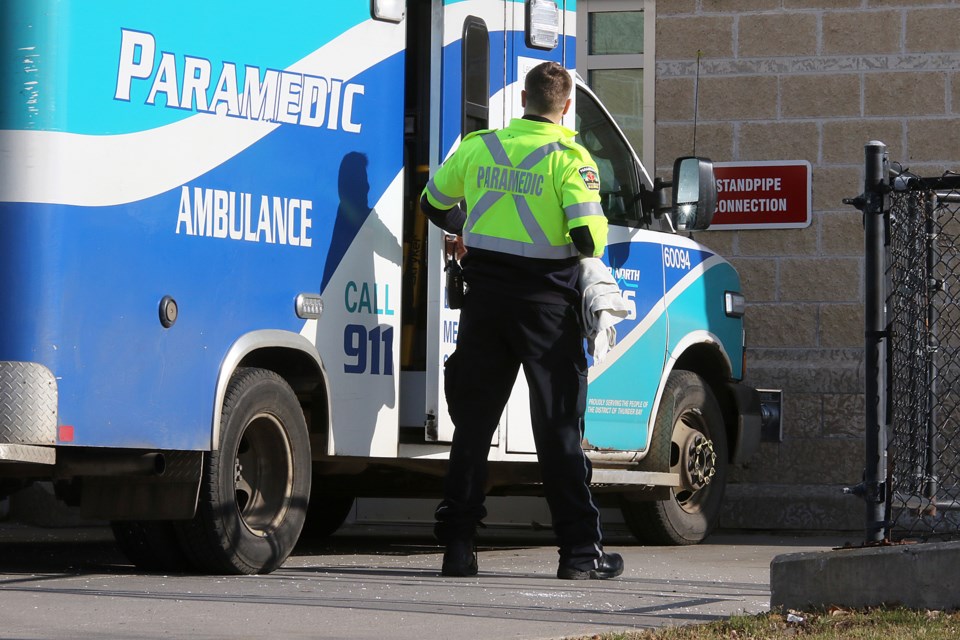THUNDER BAY – Thunder Bay’s city council has approved a 10-year plan laying out major changes for the regional paramedic service, Superior North EMS.
Elements of the plan include closing multiple bases in district communities and moving to find alternatives to hospital visits, with an emphasis on community paramedicine and the need for greater mental health and addictions treatment options.
The Superior North EMS 2021 to 2030 Master Plan was accepted as a guiding document by a unanimous vote Monday by city council.
While the agency serves 14 municipalities, First Nations, and unorganized areas throughout the District of Thunder Bay, the City of Thunder Bay has exclusive authority over its operations.
Operations are funded 50 per cent by the province, and 50 per cent by the municipalities.
Several district municipalities and First Nations have spoken out against the plan, particularly proposals to consolidate four district stations into two (Terrace Bay/Schreiber and Nipigon/Red Rock), and to close another in Beardmore.
They’ve also slammed the consultation process as practically non-existent, saying the plan was written before they had a chance to provide meaningful input.
Consultants and staff with the city and Superior North EMS have said the changes are a necessary response to massive growth in demand for service in the city of Thunder Bay, and low demand in the district.
Calls for service could increase by more than 50 per cent by 2030, from around 42,000 to around 65,000, due to an aging population and increasing willingness to call 911, the plan warns.
Emergency calls had already increased 80 per cent in volume from 2005 to 2015, despite stagnant population levels.
The plan suggests alternate models of care not requiring full ambulance crews in many cases, suggesting a paramedic continue to operate in Beardmore with a non-ambulance vehicle, based out of a local clinic.
The 12-hour ambulance service stationed in Beardmore was active only three per cent of the time, the plan found.
In Thunder Bay, that system busyness measure has recently been between 30 and 40 per cent, and spiked above 50 per cent as recently as 2015.
“The vast majority of our demand is coming from the city of Thunder Bay,” said Superior North EMS chief Wayne Gates.
However, council will retain the final decision on the recommended station closures and other major service changes, which will come back for individual votes following further planned consultation with district municipalities and First Nations in the coming months.
Staff from the city, Superior North EMS, and Performance Concepts Consulting came in for some harsh feedback from councillors on the inadequacy of consultations with district communities.
“What’s the way to describe it? I mean, clearly they don’t feel like there was anything substantive or comprehensive enough,” said Mayor Bill Mauro, who had called for greater consultation months before.
“We still find ourselves here, in this position of preparing to begin another consultation when I felt like council had put that piece in motion some time ago.”
Coun. Kristen Oliver agreed, saying she shared some of the safety concerns raised by district leaders.
“The terms of reference of the project from the beginning was to make it data-based, and once we saw what the data showed, to have the discussion at that point,” said John Prno of Performance Concepts. “In hindsight, should we have done it differently? Well, we’re finding out we have to go back now and do it differently.”
A series of four “dialogue sessions” will take place once allowed under public health rules in Nipigon/Red Rock, Schreiber/Terrace Bay, and Beardmore, with another session planned for First Nations.
Large parts of the EMS master plan rely on action from the provincial government, Oliver pointed out.
“There are a lot of hiccups in the system that certainly need to be addressed,” she said, such as a need to fund more supports like detox sites and mental health supports, diverting people from an overstretched hospital system.
The lack of adequate supports in those areas resulted in frequent long waits to offload patients at hospital, Gates told councillors.
“We were one of the first services in the province to have alterative destination, where we were able to give our paramedics the ability to take patients to detox instead of the hospital,” he said. “Unfortunately, there’s no room, so we end up going to the hospital anyway.”
“That’s a big driver of when we don’t have units available, the code black situation in Thunder Bay. If they were able to actually take our patients when we got to the hospital, I believe… we’d be able to keep up with the demand.”
The master plan envisions further scaling up community paramedicine programs, and calling for the province to make permanent a pilot project investing millions in the model over the next three years.
The plan also envisions replacing the Shuniah EMS station with a new facility, with planning – including negotiations with the municipality – beginning this year.
City of Thunder Bay staff are directed to return to council with an update on progress on the work plan by the first quarter of 2022.
